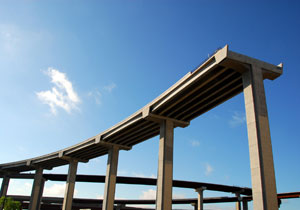The Construction Bazaar
 On Wednesday, July 11, in Washington, D.C., the Bush administration released its mid-session budget review, which updates the data included in the President’s budget released in February. The budget estimate released in February forecasted a $700 million Highway Trust Fund (HTF) shortfall in Fiscal Year (FY) 2009. This recent update increases the forecasted shortfall to more than $4 billion in FY 2009.
On Wednesday, July 11, in Washington, D.C., the Bush administration released its mid-session budget review, which updates the data included in the President’s budget released in February. The budget estimate released in February forecasted a $700 million Highway Trust Fund (HTF) shortfall in Fiscal Year (FY) 2009. This recent update increases the forecasted shortfall to more than $4 billion in FY 2009.
“America’s transportation system is the heart of our country’s economy and to neglect it is a disservice to our nation,” said Stephen E. Sandherr, CEO of the Associated General Contractors of America (AGC). “The cuts in FY 2009 from the promised level of $43.4 billion to about $27 billion, would result in a 37 percent reduction in spending on our nation’s infrastructure. Neglecting our transportation infrastructure will only make it more difficult for America to compete in the world market.”
Because of the spending rate in the HTF, it will require Congress and the President to find additional revenues to plug the $4 billion hole or cut highway funding for FY 2009 by an estimated $16 billion. That dramatic reduction in funding would impact every state in the country because the highway program is financed by gas tax revenues that are deposited into the HTF. If the deficit is not patched, it is estimated that in 2009, California would lose $1.35 billion, Florida would lose nearly $673 million, New York would lose approximately $634 million and Texas would lose more than $1.1 billion.
The mid-session review also increased the forecast shortfall to $9 billion in 2010 and to $15 billion in 2011. Those amounts will also require significant reductions in spending if Congress and the administration can not agree on methods to plug the funding gap. Transit funding will also be impacted long term, because it too is funded primarily by the HTF.
Sandherr continued: “This budget news comes at a critical juncture for the highway program, and federal, state and local governments will all feel the pinch. AGC has been working with our allies in the State DOTs on solutions to fix the problem, which we have presented to both the administration and Congress.”
Economies of Construction
According to construction economist Heather Jones at FMI (the consulting and training services company specializing in the construction industry for over 45 years), the U.S. economy is flaunting a few mixed signals.

Real GDP growth in the first quarter was 1.3 percent, according to advance estimates released by the Bureau of Economic Analysis. Fourth quarter GDP grew at 2.5 percent according to final estimates. While growth is slowing, 2007 is expected to expand at around 2.5 percent, a slower but still positive rate. FMI believes that the chances for a recession in 2007 are low, but slow growth will be a reality.
A recession is defined as three quarters of negative growth, not slower growth. The unemployment rate is essentially unchanged at 4.5 percent, which is near historic lows. The unemployment rate has stayed within a narrow range of 4.4 to 4.6 percent since September 2006. Employment increased by 88,000 in April to 137.7 million. From January to April 2007, employment gains averaged 129,000 per month, compared with 189,000 per month for the same period in 2006. Construction employment was little changed in April with no significant movements among the component industries. From January to April 2007, there has been essentially no net change in construction employment.
The Conference Board’s Consumer Confidence Index retreated in April, after decreasing in March.
The Consumer Confidence Index is viewed as a leading indicator for consumer spending, which drives two-thirds of the U.S. economy.The Index is now 104.0, down from 108.2 in March.
“Unlike the decline in March, which was solely the result of apprehension about the short-term outlook, this month’s decline was a combination of weakening expectations and a less favorable assessment of present-day conditions. Rising prices at the gas pump continue to play a key role in dampening consumers’ short-term expectations,” says Lynn Franco, director of The Conference Board Consumer Research Center. “The decline in the Present Situation Index – the first decline in six months – warrants monitoring in the months ahead, as further declines would suggest a softening in growth.”

Comments are closed here.